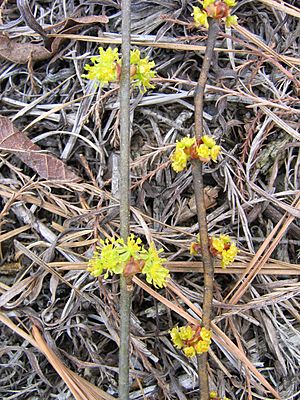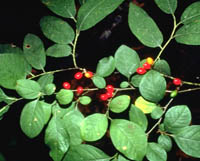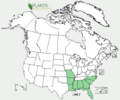Pondberry facts for kids
Quick facts for kids Pondberry |
|
|---|---|
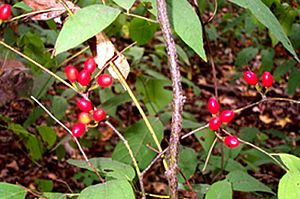 |
|
| Conservation status | |
| Scientific classification | |
| Genus: |
Lindera
|
| Species: |
melissifolia
|
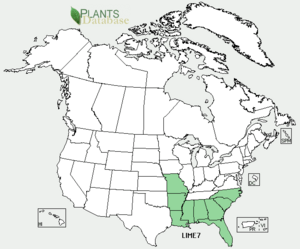 |
|
| Natural range in North America | |
| Synonyms | |
|
|
The Lindera melissifolia, also known as pondberry or southern spicebush, is a special kind of shrub. It grows from underground stems called stolons and loses its leaves every year (it's deciduous). This plant also smells nice, like spices!
Pondberry belongs to the laurel family. Sadly, it is an endangered species. This means there are not many left in the wild. It grows naturally in the southeastern United States. A big reason it's disappearing is because its wet homes (called wetlands) are being drained. People drain these areas for farms and cutting down trees. But don't worry, people are working hard to help pondberry survive!
Contents
What Does Pondberry Look Like?
Plant Shape and Size
Pondberry plants often grow in thick groups called thickets. They have straight stems that can reach about 6.5 feet (2 meters) tall. These stems don't have many branches. All the stems in a thicket are connected underground by stolons. This means they are often all part of the same plant!
Female pondberry thickets are usually smaller than male ones. Sometimes, female plants are not found in a group at all. It's common for some stems to die back, but new ones usually grow.
Leaves and Smell
The leaves of the pondberry hang down. They are long and oval-shaped, about 2 to 6 inches (5-16 cm) long. They are also about 1 to 2.5 inches (2-6 cm) wide. The leaves often come to a sharp point at the end.
If you look at the underside of a leaf, you'll see strong veins. It also has short, soft hairs. When you crush a pondberry leaf, it smells a lot like sassafras. The leaves fall off in the autumn.
Flowers and Pollination
Pondberry plants start to flower when they are two to four years old. The male and female flowers grow on different plants. This is called being dioecious. The flowers appear before the leaves, usually from February to mid-March.
Each flower is small, about 0.2 inches (5-6 mm) across. They grow in tight groups without stalks. The flower parts that look like petals are pale to bright yellow. They are about 0.08 inches (2 mm) long. Male flowers have many stamens (the parts that make pollen). Female flowers are smaller and have fewer flowers in each group. They have one pistil (the part that makes seeds).
The flowers stay open for about one week. This makes the thickets easy to spot! Insects probably help pollinate the flowers. Sometimes, late frosts can hurt the flowers. This means fewer fruits will grow.
Fruit and Seeds
In late summer or fall (August to early October), pondberry grows bright red fruits. These fruits are called drupes. They are oval-shaped and about 0.4 to 0.5 inches (10-12 mm) long. Each fruit has one seed inside.
The stalks that hold the fruit are about 0.4 to 0.5 inches (9-12 mm) long. They are also about 0.1 inches (2.5-3 mm) thick. These stalks stay on the plant even after the fruit falls off. Seeing them can tell you if the plant was male or female. It also shows how much fruit it made. The number of fruits can change a lot each year. Some stems might have no fruit, while others have up to 150!
Where Does Pondberry Live?
Pondberry likes to live in wet places. You can find it in shallow ponds in wetlands. It also grows along the edges of cypress ponds. Sometimes, it's in low, wet areas among hardwood trees.
Today, there are about 36 groups of pondberry plants. They are found in Alabama, Arkansas, Georgia, Mississippi, Missouri, North Carolina, and South Carolina. It seems to have disappeared from Louisiana and maybe Florida. Many pondberry groups are in the Lower Mississippi Alluvial Plain. The biggest group is in the Delta National Forest in western Mississippi.
Pondberry's Environment
Pondberry has probably always been a rare plant. We don't know a lot about how it lives in nature. In Mississippi, it lives in forests with hardwood trees. In Arkansas and Missouri, it grows in and around shallow ponds that dry up sometimes. In South Carolina, it lives near karst areas, which have sinkholes. In Georgia, it's found near sphagnum bogs.
Pondberry can grow in many different light conditions. Some grow in deep shade, while others are in almost full sunlight. Most pondberry groups prefer light shade under trees. It seems pondberry can live in many places as long as it gets enough water. If it grows in open, sunny spots, other plants might compete with it.
Many pondberry groups today have only male plants. This means they are all sprouts from one original plant. When habitats get broken up, it's hard for plants like pondberry to survive. If a group only has male plants, it can only make new plants from its underground stems. It can't make seeds. As places to live shrink, plants become more separated. This makes it harder for insects to carry pollen from male to female plants.
Pondberry Reproduction and Life Cycle
Pondberry plants mainly spread using their underground stems (stolons). This way of growing new plants is called vegetative reproduction. It's how most pondberry groups get bigger. Stems usually live for 6 or 7 years. When an old stem dies, a new one often grows from the base. So, older groups of pondberry often have both dead and live stems.
Even though pondberry makes many fruits with seeds, we almost never see new seedlings growing in the wild. We don't know why this happens. But it means the plant has a harder time surviving long-term. Making seeds (sexual reproduction) is very important. It helps pondberry spread to new places. It also helps create different kinds of pondberry plants.
Long ago, big floods from the Mississippi River might have helped. They could have carried pondberry fruits or seeds far away. Floods might also have created good places for new seedlings to grow. Pondberry fruit sinks in water after a short time. But if you take the pulp off the seed, it can float for a day or more.
The bright red color, soft fruit, and how long the fruit stays on the plant suggest that animals help spread the seeds. Birds are probably very important seed dispersers. Scientists watched 82 kinds of birds near pondberry plants with fruit. Only two kinds ate the fruit: hermit thrushes and northern cardinals. Cardinals crushed the seeds, so they are seed predators. But hermit thrushes swallowed the whole fruit. Then, they spit out the seed later. This means hermit thrushes are important seed dispersers. Thrushes usually spread seeds within about 330 feet (100 meters) of where they ate the fruit.
Other animals might also spread pondberry seeds. These include raccoons and opossums. Long ago, black bears might have helped spread the seeds too.
It seems that pondberry seeds can grow well. High rates of seeds growing have been seen in labs and in the wild. If you remove the fruit's pulp and plant the seeds in soil, they grow better. In the wild, planted seeds can grow over several years. This means some seeds might be "sleeping" (have dormancy) for a while.
We might need to plant pondberry in new areas to help it recover. Plants have been moved successfully from existing groups to good new spots. Some of these moved plants do well, but others don't grow much. Both moved plants and seedlings grow well in nurseries. These nursery plants are then used to start new groups in the wild.
What Uses Does Pondberry Have?
Hermit thrushes and northern cardinals eat pondberry fruit. Other birds might eat it too. Animals seen eating pondberry seeds from the ground include: northern cardinals, brown thrashers, swamp rabbits, armadillos, and gray squirrels. Swamp rabbits have also been seen eating the stems.
The larvae (young) of the spicebush swallowtail butterfly eat pondberry leaves. They roll themselves up in a leaf to make a little tent! Leaf cutter bees cut round pieces from the edges of the leaves. Sometimes, they take most of the leaf.
A long time ago, children in the southern United States used pondberry fruits. They used them as bullets in toy pop guns. These toy guns were made from hollowed-out elderberry stems.
Threats to Pondberry
A lot of pondberry's home disappeared. Forests were cut down for wood or to make farms. Many wet areas were also drained. In some places, wetlands were even flooded to make lakes. Many pondberry groups that are left are small. They only live in a small part of the good habitat that's still there.
Pondberry, being in the Laurel family, might be in danger from a disease called laurel wilt. This disease is caused by a fungus. It's brought to plants by a beetle from other countries, called the redbay ambrosia beetle. The fungus blocks the plant's water pipes. This makes the plant wilt and die. There is no known cure for this disease. It has spread quickly through other plants in the laurel family. It is now moving towards where pondberry lives.
Helping Pondberry Recover
Pondberry was listed as endangered in 1986. The U.S. Fish and Wildlife Service has a plan to help it. This plan says:
- Protect existing pondberry groups from logging and farming.
- Protect them from animals that might eat them.
- Keep looking for new pondberry groups.
- Protect areas that look like good pondberry homes, even if no plants are there yet.
- Start new pondberry groups or bring them back to places where they used to live.
A very important part of helping pondberry is learning more about how it lives and reproduces. Scientists from the U.S. Forest Service and the U.S. Army Corps of Engineers are working with the U.S. Fish and Wildlife Service. They want to learn everything they can about pondberry.
Scientists are studying how floods and light affect pondberry. They are also doing experiments to learn about plant competition. They study how seeds sprout, how to store seeds, and how long seeds stay alive in the soil. They are looking at many things to help pondberry. This includes its ecology, insects that eat it, plant diseases, how it reacts to light and water, its genetics, how its seeds work, and how its seeds are spread.
Images for kids



